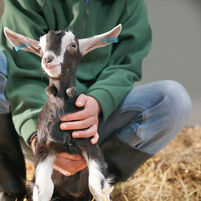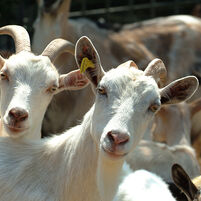Animal welfare


The safety of the food chain is directly connected to the welfare of animals, particularly those farmed for food production, due to the close links between animal welfare, animal health and food-borne diseases. Stress factors and poor welfare can lead to increased susceptibility to transmissible Capable of being passed between individuals in the same species, as well as between different species (e.g. from animals to humans). diseases among animals. This can pose risks to consumers, for example through common food-borne infections such as Salmonella, Campylobacter and E. coli. Good animal welfare practices not only reduce unnecessary suffering but also help to make animals healthier. In addition, the Lisbon Treaty of 2009 included an explicit recognition that animals are sentient beings and that the EU and its Member States bear an ethical responsibility to prevent maltreatment, pain and suffering.
The welfare of food-producing animals depends largely on how they are managed by humans. A range of factors can impact on their welfare from housing and bedding, space and crowding, transport conditions, stunning and slaughter methods, to castration of males and tail docking.
Latest
EFSA recommends avoiding the permanent use of boxes, cages and crates to improve the welfare of cats and dogs in commercial breeding establishments. EFSA’s new scientific report supports potential legislative measures for the protection of cats and dogs in commercial breeding kept for sport, hunting and companion purposes.
Milestones
2023
May
Dairy cows, ducks, geese and quail need more space and improved housing according to animal welfare recommendations published in two new scientific opinions by the European Food Safety Authority (EFSA). The opinions form part of a series on farmed animal species A subdivision of the genus, a species is a group of closely related and similar-looking organisms; for example, in the case of Homo sapiens (humans), the second part of the name (sapiens) represents the species. that support the ongoing revision of the European Union’s animal welfare rules. Check our news story and infographics on dairy cows and on ducks, geese and quail.
March
Veal calves should be housed in small groups during their first weeks of life and the use of individual pens should be avoided to improve their welfare, according to a scientific opinion by EFSA. Check our news story, plain language summary and infographic.
February
To improve the welfare of farmed broiler chickens and laying hens, EFSA’s scientists recommend avoiding the practice of mutilation, feed restriction and the use of cages in two new scientific opinions. Check our news release and infographic.
2022
September
EFSA recommends more space, lower temperatures, shorter journeys to improve animal welfare during transport in new five scientific opinions.
August
EFSA provides recommendations to improve the welfare of farmed pigs in the first assessment delivered in the context of Farm to Fork (F2F) strategy.
July
The methodological guidance for the development of welfare mandates in the context of the Farm to Fork strategy is published.
February
EFSA launches an open consultation on the draft of a guidance methodology to be used for a series of scientific opinions on the welfare of farmed animals.
EFSA’s role
Animal welfare is an increasingly important part of EFSA’s remit. The agency’s scientific assessments help risk managers identify methods to reduce unnecessary pain, distress and suffering for animals and to improve welfare wherever possible. EFSA’s Panel on Animal Health and Welfare assesses factors such as housing and management, transport and slaughter of farmed animals such as pigs, sheep, poultry, cattle and fish. Our stakeholders play a central role in issuing recommendations and guidelines, identifying issues of concern and providing feedback on EFSA’s activities and our scientific approach.
Harmonised methodology
EFSA’s experts use a guidance document that includes a methodology for assessing risks to animal welfare that considers husbandry systems, management procedures and welfare issues. Prior to the development of this guidance in 2011, there had been no specific international guidelines on risk assessment A specialised field of applied science that involves reviewing scientific data and studies in order to evaluate risks associated with certain hazards. It involves four steps: hazard identification, hazard characterisation, exposure assessment and risk characterisation. for animal welfare. Scientists, veterinarians and all those with an interest in animal welfare were involved in drafting the harmonised methodology, which will be revised in the next couple of years.
We work to translate good science into practical application by working with farmers, policy makers, food processors and retailers, advisory bodies and welfare charities, thereby raising animal welfare standards. We are also committed to raising awareness, and to open communication with all members of society about our work.
Animal-based measures
As part of its Animal Welfare Strategy 2012-15, the European Commission called for measurable animal welfare indicators to be developed to reinforce the scientific basis of EU regulation in this field. EFSA subsequently developed a set of indicators – “animal-based measures” – to be included in its welfare assessments. EFSA published three scientific opinions on the use of animal-based measures for animal welfare assessment. The opinions covered pigs, dairy cows, and broilers. EFSA also published a general statement on the use of animal-based measures to assess animal welfare.
The factors that affect an animal’s welfare include the physical environment and resources available to the animal, such as space allocation and bedding material, and the management practices the animal is subjected to, such as feeding strategies and transport plans. Each animal will respond differently to these factors according to its own characteristics (age, sex, breed); these responses are assessed using animal-based measures. Animal-based measures can be identified either by observation or inspection of the animal – for direct measures such as behaviour, body conditions, presence of injuries – but can also include records obtained using automated methods (for indirect measures such as water consumption).
Animal-based measures can therefore support decision-making on acceptable conditions for farmed animals and can be used to underpin monitoring and control programmes, implemented at farm level, to guarantee standards of animal health and welfare and to help control diseases.
EU framework
Standards of animal welfare in the EU are among the highest in the world. Harmonised EU rules are in place covering a range of animal species and welfare issues. Council Directive 98/58/EC lays down the minimum standards for the protection of all farmed animals, while other EU legislation sets welfare standards for farmed animals during transport and at the time of stunning and slaughter. Specific directives cover the protection of individual animal categories such as calves, pigs, laying hens and chickens kept for meat production. In addition to farmed animals, animals used in laboratory tests and wild animals kept in zoos are also protected by harmonised EU standards. The legislation will be revised over the next few years (see below).
Other international organisations have also issued recommendations and guidelines concerning animal welfare, such as the World Organisation for Animal Health (OIE) and the Council of Europe. The EU is a signatory to the European Convention for the protection of animals kept for farming purposes, adopted by the Council of Europe.
Farm to Fork review
Animal welfare is an integral part of the European Union’s new Farm to Fork (F2F) strategy, which aims to make agriculture practices in Europe more sustainable through an integrated food policy that covers the full supply chain. As part of F2F, the EU is undertaking a comprehensive evaluation of its animal welfare legislation, for which EFSA has been asked to provide new advice that reflects the most up-to-date scientific research and data. The new mandates received by EFSA also reflect growing public concern around animal welfare, particularly the use of cages in animal farming. A European Citizens’ Initiative (End the Cage Age) calling for an end to use of such cages was signed by more than 1.5 million citizens and supported by around 170 organisations.
The work falls broadly into three areas:
Welfare of animals during transport.This will cover six groups of animals: equids (horses, donkeys); bovines (cattle and calves); small ruminants (sheep and goats); pigs; domestic birds; and rabbits. For each group, EFSA will provide a comprehensive breakdown of existing transport practices and:
- Describe the relevant welfare consequences during each step of the transport process;
- Define animal-based measures for assessing the welfare consequences during transport;
- Identify the hazards leading to these welfare consequences;
- Provide recommendations to prevent, mitigate or correct the welfare consequences.
Welfare of animals at slaughter. EFSA has almost completed its series of assessments looking at welfare aspects of the slaughter of animals for human consumption and on-farm killing for other purposes (e.g. disease and population Community of humans, animals or plants from the same species. control). Opinions have been published on poultry (2019), as well as rabbits (January 2020) and pigs (June 2020). Additional opinions on cattle are due later in 2020. The opinions identify hazards, animal-based measures and preventive and corrective measures for each step of the slaughter process, from arrival of the animals at the slaughterhouse and unloading from the truck, to waiting in lairage, stunning and bleeding.
Welfare of animals kept for farming purposes. These opinions will consider welfare of poultry (laying hens and chickens reared for meat), pigs and calves. For each category of animals, an opinion will describe current husbandry systems and practices; identify relevant hazards, welfare consequences and associated animal-based measures; and provide recommendations for preventing or correcting the welfare consequences.
The safety of the food chain is directly connected to the welfare of animals, particularly those farmed for food production, due to the close links between animal welfare, animal health and food-borne diseases. Stress factors and poor welfare can lead to increased susceptibility to transmissible diseases among animals. This can pose risks to consumers, for example through common food-borne infections such as Salmonella, Campylobacter and E. coli. Good animal welfare practices not only reduce unnecessary suffering but also help to make animals healthier. In addition, the Lisbon Treaty of 2009 included an explicit recognition that animals are sentient beings and that the EU and its Member States bear an ethical responsibility to prevent maltreatment, pain and suffering.
The welfare of food-producing animals depends largely on how they are managed by humans. A range of factors can impact on their welfare from housing and bedding, space and crowding, transport conditions, stunning and slaughter methods, to castration of males and tail docking.
Don't miss
Published on this topic
Expert group

Experts in veterinary sciences, microbiology and pathology, and animal production.